Solution-Driven CMMC Implementation – Solve First, Ask Questions Later
We’re halfway through 2020 and we’re seeing customers begin to implement and level up within the Cybersecurity Maturity Model Certification (CMMC) framework. Offering a cyber framework for contractors doing business with the DoD, CMMC will eventually become the singular standard for Controlled Unclassified Information (CUI) cybersecurity.
An answer to limitations of NIST 800-171, CMMC requires attestation by a Certified Third-Party Assessor Organization (C3PAO). Once CMMC is in full effect, every company in the Department of Defense’s (DoD’s) supply chain, including Defense Industrial Base (DIB) contractors, will need to be certified to work with the Department of Defense.
As such, DIB contractors and members of the larger DoD supply chain find themselves asking: when should my organization start the compliance process, and what is the best path to achieving CMMC compliance?
First, it is important to start working toward compliance now. Why?
- – Contracts requiring CMMC certification are expected as early as October and if we wait to certify until we see an eligible contract, it’s too late.
- – You can currently treat CMMC compliance as an “allowable cost.” The cost of becoming compliant (tools, remediation, preparation) can be expensed back to the DoD. The amount of funding allocated to defray these expenses and the allowable thresholds are unclear but the overall cost is likely to exceed initial estimates and as with any federal program, going back for additional appropriations can be challenging.
As far as the best path to achieving CMMC goes – the more direct, the better.
Understanding Current Approaches to CMMC Compliance
CMMC is new enough that many organizations have yet to go through the compliance process. Broadly, we’ve seen a range of recommendations, most of which start with a heavy upfront lift of comprehensive analysis.
The general process is as follows:
- Assess current operations for compliance with CMMC, especially as it relates to its extension of NIST 800-171 standards.
- Document your System Security Plan (SSP) to identify what makes up the CUI environment. The plans should describe system boundaries, operation environments, the process by which security requirements are implemented, and the relationship with and/or connections to other systems.
- Create a logical network diagram of your network(s), including third-party services, remote access methods, and cloud instances.
- List an inventory of all systems, applications, and services: servers, workstations, network devices, mobile devices, databases, third-party service providers, cloud instances, major applications, and others.
- Document Plans of Action and Milestones (POAMs). The POAMs should spell out how system vulnerabilities will be solved for and existing deficiencies corrected.
- Execute POAMs to achieve full compliance through appropriate security technologies and tools.
This assessment-first approach, while functional, is not ideal.
In taking the traditional approach to becoming CMMC compliant, the emphasis is put on analysis and process first; the tools and technologies to satisfy those processes are secondary. By beginning with a full compliance assessment, you are spending time guessing where your compliance issues and gaps are, and by deprioritizing technology selection, potentially relying upon multiple tools, there is the potential to have granular processes that increase the problem of swivel-chair compliance (e.g., having to go to multiple tools and interfaces to establish, monitor, and maintain compliance and the required underlying cybersecurity). This is actually creating more work for your compliance and security team when you have to architect an integrated, cohesive compliance solution.
Then, the whole process has to be redone every time a contractor’s compliance certification is up.
Big picture, having to guess at your compliance gaps upfront can lead to analysis paralysis. By trying to analyze so many different pieces of the process and make sure they’re compliant, it is easy to become overwhelmed and feel defeated before even starting.
With NIST 800-171, even though it has been in effect since January 1, 2018, compliance across the DIB has not been consistent or widespread. CMMC is effectively forcing the compliance mandate by addressing key loopholes and caveats in NIST 800-171:
- – You can no longer self-certify.
- – You can no longer rely on applicability caveats.
- – There is no flexibility for in-process compliance.
So, if you’ve been skirting the strictness of compliance previously, know you can no longer do that with CMMC, and are overwhelmed with where to even begin, we recommend you fully dive into and leverage a tool that can be a single source of truth for your whole process – Splunk.
Leverage a Prescriptive Solution and Implementation Consultancy to Expedite CMMC Compliance
Rather than getting bogged down in analysis paralysis, accelerate your journey to CMMC compliance by implementing an automated CMMC monitoring solution like Splunk. Splunk labels itself “the data to everything platform.” It is purpose-built to act as a big data clearinghouse for all relevant enterprise data regardless of context. In this case, as the leading SIEM provider, Splunk is uniquely able to provide visibility to compliance-related events as the overlap with security-related data is comprehensive.
Generally, the process will begin with ingesting all available information across your enterprise and then implementing automated practice compliance. Through that implementation process, gaps are naturally discovered. If there is missing or unavailable data, processes can then be defined as “gap fillers” to ensure compliance.
The automated practice controls are then leveraged as Standard Operating Procedures (SOPs) that are repurposed into applicable System Security Plans (SSPs), Plans of Action and Milestones (POAMs), and business plans. In many cases, much of the specific content for these documents can be generated from the dashboards that we deliver as a part of our CMMC solution.
The benefits realized by a solution-driven approach, rather than an analysis-driven one, are many:
- Starting with a capable solution reduces the overall time to compliance.
- Gaps are difficult to anticipate, as they are often not discovered until the source of data is examined (e.g. one cannot presume that data includes a user, or an IP address, or a MAC address until the data is exposed). Assumption-driven analysis is foreshortened.
- Automated practice dashboards and the collection of underlying metadata (e.g authorized ports, machines, users, etc.) can be harvested for document generation.
- Having a consolidated solution for overall compliance tracking across all security appliances and technologies provides guidance and visibility to C3PAOs, quelling natural audit curiosity creep, and shortening the attestation cycle.
Not only does this process get you past the analysis paralysis barrier, but it reduces non-compliance risk and the effort needed for attestation. It also helps keep you compliant – and out of auditors’ crosshairs.
Let Splunk and TekStream to Get You Compliant in Weeks, Not Months
Beyond the guides and assessments consulting firms are offering for CMMC, TekStream has a practical, proven, and effective solution to get you compliant in under 30 days.
By working with TekStream and Splunk, you’ll get:
- – Installation and configuration of Splunk, CMMC App, and Premium Apps
- – Pre/Post CMMC Assessment consulting work to ensure you meet or exceed your CMMC level requirements
- – Optional MSP/MSSP/compliance monitoring services to take away the burden of data management, security, and compliance monitoring
- – Ongoing monitoring for each practice on an automated basis and summarized in a central auditing dashboard.
- – Comprehensive TekStream ownership of your Splunk instance, including implementation, licensing, support, outsourcing (compliance, security, and admin), and resource staffing.
If you’re already a Splunk user, this opportunity is a no brainer. If you’re new to Splunk, this is the best way to procure best-in-class security, full compliance, and an operational intelligence platform, especially when you consider the financial benefit of allowable costs.
If you’d like to talk to someone from our team, fill out the form below.


